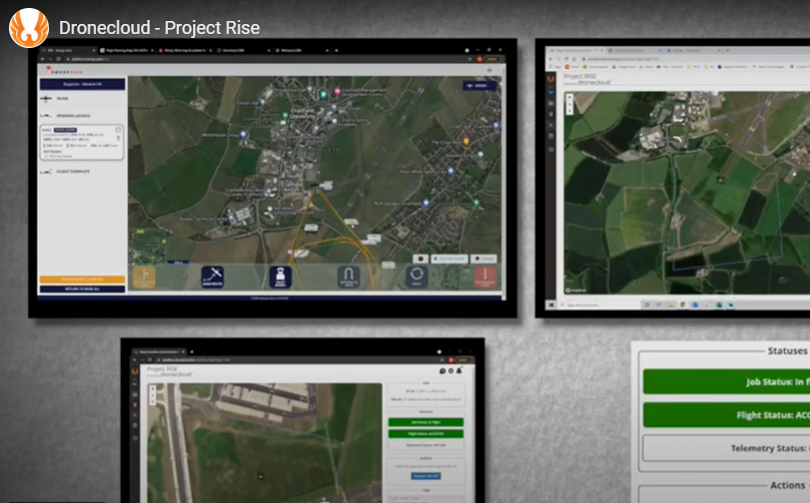The UK Future Flight Challenge Consortium consisting of Dronecloud, Frequentis, Sky-Drones, Cranfield University and Skyports reports successful completion of Project RISE. Project RISE is funded by Innovate UK, through Phase 2 of the UK government’s Future Flight Challenge to help unlock the future of drone operations through consolidating UTM services. Field trials were successfully completed at Cranfield Airport in the UK in November 2021, demonstrating a working solution.
Integrations were developed between a Ground Control Station (GCS), an Unified Traffic Management Service Provider (UTMSP) and an Air Traffic Control (ATC) interface to increase levels of automation of approvals and ATC in non-segregated airspace. It is delivered through Application Programming Interfaces (APIs), enabling future integrations with other drone manufacturers and UTM service providers, taking the drone industry a step closer towards unlocking beyond visual line of sight (BVLOS) flights at scale.
Project RISE brings together three independent layers of software to create an intelligent integrated system, with a complete workflow of drone operations from flight planning to in-flight to post-flight auditing. The systems work together to provide different interfaces to drone operators and air traffic controllers, seamlessly allowing both groups of users to have complete visibility of flight plans before flight, as well as a drone’s location during flight in relation to approved parameters and controlled areas.
Rather than creating a proprietary closed stack of UTM services within a single platform, RISE demonstrates an open approach to delivering a range of UTM services across multiple integrated platforms in a flexible and inclusive way. Integrations were delivered through open standard APIs, allowing various commercial drone operators, drone manufacturers and UTM service providers to connect through these integrations. Frequentis is using in-house expertise from various ATM, UTM, Public Safety and Transport domains to address the needs of all impacted stakeholders.
“Sky-Drones has focused on the Uncrewed Aerial System (UAS) hardware and software being used throughout project RISE. Our technology allows us to fly drones beyond visual line of sight from anywhere in the world, plan complex missions and record the flight data with comprehensive post-flight analytics,” noted Kirill Shilov, Founder & CEO of Sky-Drones.”
Cranfield University completed an analysis of radio link connectivity in UAS to highlight the factors which affect connectivity performance needed for BVLOS, together with mitigation plans to improve it. Dr Saba Al-Rubaye, Reader in Autonomous and Connected Systems at Cranfield University, says “Cranfield is leading hardware system integration to address current and future challenge of UAS communications. We were delighted to support Project RISE in the field trials by providing Airport facilities and conducting analysis of different communication scenarios to guarantee high quality of services (QoS) for drone safety.”
The field trials at Cranfield Airport demonstrate a live/working airport environment use-case but the potential applications go far beyond. Project RISE is a step towards complete integration of UAS and traditional air traffic anywhere, and in doing so, moving towards fully scalable BVLOS operations. Consortium members are keen to build on the project success and keep innovating towards this shared vision.
Jan Domaradzki, CEO of Dronecloud said: “Through integrations between these systems, we can share automatically electronic ID, flight telemetry data, alerts and other communications. The increased safety and efficiency helps break down barriers to scale. At the same time, readying the software platforms towards participating in all UTM regulatory frameworks, such as the UK’s Open Access UTM Framework and U-Space. Project RISE is a genuine step forward for the industry as a whole and brings us closer to integrating crewed and uncrewed traffic in controlled airspace, and in doing so, a step also towards unlocking the potential of scalable BVLOS and autonomy. We’re incredibly proud to have worked with such a strong team to deliver Project RISE,”
Find out more about the project at https://dronecloud.io/dclabs#projectrise
For more information visit:




